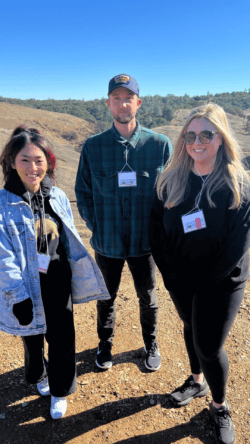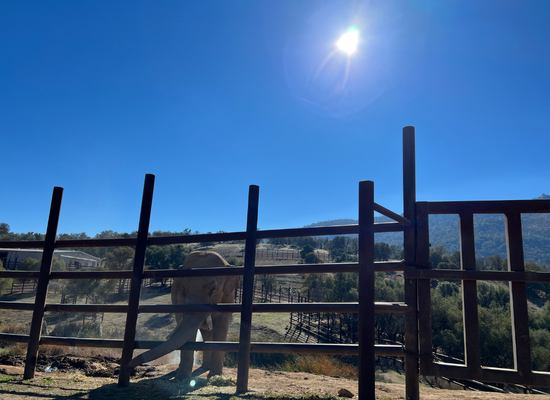As part of our work to secure the right to liberty for our unlawfully imprisoned clients, the NhRP demands their release to sanctuary. This is because, as with many captive nonhuman animals, being released back into the natural habitats they were stolen from (or their mothers were stolen from) is not feasible. Years in captivity leaves animals physically and mentally traumatized, too accustomed to human contact and ill-equipped with the skills needed to survive in the wild. Thankfully, there are places of refuge for our clients to go–places where their right to liberty will be respected. One such refuge is the the world-renowned Performing Animal Welfare Society (PAWS) ARK 2000 sanctuary in San Andreas, CA.
In November, NhRP Staff Attorney Jake Davis, NhRP Government Relations and Campaigns Director Courtney Fern, and I visited PAWS, which provides lifelong care for animals who were once exploited by circuses, zoos, and private captors. It is one of two accredited sanctuaries in the US that house rescued or retired elephants.

Founded in 1984 by the late Pat Derby, a former Hollywood animal trainer, and Ed Stewart, president and anti-captivity advocate, PAWS operates three sanctuaries in California, including ARK 2000, currently home to bears, big cats, and elephants. The PAWS sanctuary is not open to the public; however, we were fortunate enough to attend their annual conference, including a tour of ARK 2000 where a limited number of people are invited to see the vast property, the work that takes place there, and–from afar–the animals.
In shuttles, we were driven deep into the valleys of San Andreas in northern California where the sight of people and buildings became few and far between. Several miles down an unmarked dirt road, we came to a stop in front of a metal gate. If it weren’t for the PAWS logo adorned across it, you would never guess that behind it live seven rescued elephants across an expanse of 2,300 acres.
We stepped off the shuttle at the top of the valley where you could see the entire sanctuary. There was a sense of calm from this vantage point as the group collectively took in the crisp air, the peaceful sound of birds, and the sight of the treeline. Looking down the valley, we spotted three elephants. From where we were standing, they looked so small, and a woman who was also part of the tour offered me her binoculars. Through them I could see two elephants standing closely together. They faced one another while grazing the grass with their trunks and occasionally brushing each other. These two elephants, I later learned, were named Mara and Thika (more on them later). I pointed the binoculars slightly upwards to see another elephant, Prince, not too far behind them. Prince, an Asian bull elephant who arrived at PAWS in 2011, was laying on his side on a pile of dirt, his legs out in front of him. He looked so relaxed as he lay sleeping in a patch of sun.

We jumped back onto the shuttle and drove down the property to see the two female African elephants we’d seen at the top of the valley. Mara, a wild-born elephant, was torn from her natural habitat at the age of two and taken to the US where she was moved from roadside zoo to roadside zoo. She suffered years of abuse and exploitation including being trained with a bullhook to “entertain” zoo patrons. Thanks to PAWS, a group called Friends of Mara, and other advocates, she was rescued and arrived at the sanctuary in 1990, making her one of the first elephants to find sanctuary at PAWS. Thika, on the other hand, is a captive-born elephant. She was born at the Toronto Zoo and spent more than 30 years there before arriving at PAWS after the Toronto Zoo board voted to end the zoo’s elephant program in 2011. Mara saw a familiar face in Ed and came down the hill to greet him at the gate. Thika, who had been busy foraging up at the top of the hill, joined Mara shortly afterwards. She came running down the hill and the two trumpeted as they raised their trunks and playfully nudged each other’s sides. Their trumpeting boomed so loudly in contrast to our surroundings and it struck me then that I had never seen or heard elephants interact this way at a zoo. Ed threw carrots, mandarins, and leafy greens by their feet and it was fascinating to watch how dexterous Mara and Thika’s trunks were as they grabbed for their favorite foods.
We were then taken to see Nicholas, a second Asian bull elephant. Nicholas was born in a circus breeding facility where he was trained to ride a tricycle and perform in a circus after being permanently separated from his mother. He arrived at PAWS after the circus deemed him too difficult to manage or train. One of the volunteers at PAWS told us he was severely traumatized when he first arrived at PAWS and it took him some time to trust humans. Now 28 years old, Nicholas likes to spend his time playing in the water, and the PAWS staff and volunteers have come to learn that his favorite treat is dry bran.
While I was at PAWS, I couldn’t help but imagine what the lives of Happy, Minnie, Amahle, Nolwazi, Vusmusi, and Mabu would be like in a sanctuary. PAWS staff themselves recognize that no sanctuary, including PAWS, can ever fully replicate elephants’ natural habitat and the lives they should have had had they never been forced into captivity. However, in a sanctuary where their right to liberty is respected and protected, our clients could have the autonomy to choose how they spend their time and with whom. Instead of tiny, human-made enclosures, they could have hundreds of acres of natural habitat to roam with access to water features, trees, shrubs, and pastures. Like the elephants who reside at PAWS, our clients and other captive elephants could begin to heal, engage in their innate behaviors, and most important of all, regain their freedom.
Watch our interview with Catherine Doyle, the PAWS Director of Science, Research, and Advocacy, where she discusses what life is like for the elephant residents at PAWS sanctuary. To learn more about PAWS, visit their website.